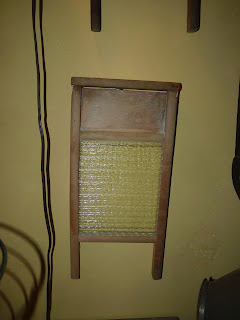This is the one I painted up and used in storytelling programs. I had a great time painting it! I loved it, but then I broke one of the legs. My father did a great job fixing it, but he had it so long I got out of the habit of using it and never picked it up again. This was one of the washboards I used to wash clothes back in the days when we didn't have electricity here (1976-1989). I usually took our laundry to the laundromat, washed the clothes there and then brought them home to hang outside to dry. But in summer, and sometimes in winter as well when the roads were too bad to get into town, I would wash some of the clothes at home to save money. Washing on a washboard is hard work--scrubbing without taking the skin off your knuckles in an art too. I learned to soak clothes well before attempting to scrub them. I had a set of laundry tubs (still have them, in fact) and a hand-cranked wringer that was mounted between the tubs. I'd fill one tub with hot soapy water and the other with clear rinse water; then I'd scrub the clothes, run them through the wringer, swish them in the rinse water and wring them again. I learned the hard (and expensive) way that the wringer was hard on zippers and buttons. I would fold anything with zippers in a special way to get them safely through the wringer.
This was my other washboard that I used for laundry. This was a new one in 1976, and it did not hold up to use. The rubbing metal part is separated from the frame. Now it stands on the fireplace mantel as a tribute to those older, hard-working days.
Then there's this small washboard, made for washing fine linens,
and a painted one I bought at a yard sale years ago.
This small glass washboard is also for fine linens
but this larger glass board was meant to used just like the metal boards. I never attempted to use either of these, preferring to just look at them. I have seen blue ceramic boards too, which I think are beautiful--but not affordable for me.
This last photo isn't of a washboard; it's of the hand-cranked washing machine I also used to use. This one was strictly for summer time, but it worked very well, and talk about a cardiovascular workout! You can't see it very well in the picture--it's hidden in the corner by the lamp. It looked like a barrel, with a wringer on top and a crank handle on the side attached to gears that were attached to a milk-stool-looking agitator. When the crank was turned the agitator would turn left and right, pushing the clothes around on the corrugated wood surface inside. It worked amazingly well. Sadly, it fell into bad condition; in this photo it is literally propped up in the corner. And when we bought bookshelves to put along this wall, we had to move the old washer out. It literally fell into pieces. I still have the pieces and have this probably unrealistic hope that one day it will be reconstructed. It was such a part of my life. I bought it from the son of the original owner. He said his mother bought it from a Sears Roebuck catalog in the 1890's.
Perhaps one day we will be able to get it repaired, or give it to someone who could do it.
Copyright 2012 Susanna Holstein. All rights reserved. No Republication or Redistribution Allowed without attribution to Susanna Holstein.






Great collection - love the stories that go with them!
ReplyDeleteGreat collection. Love our comments and stories that go with it.
ReplyDeleteJust last weekend I heard a 1920s style band that had a guy playing the washboard. It is an art to play as well. He was amazing to hear. He could make so many sounds come from that board...
ReplyDeleteLOVE those washboards and you are making me think I need one! My grandmother used to wash with that kind of washing machine. I would help her when we would stay with her in the summer. Good memories.
ReplyDeleteI can't even imagine using a washboard, and it's so interesting to hear your experiences.
ReplyDeleteThanks for sharing them.
=)